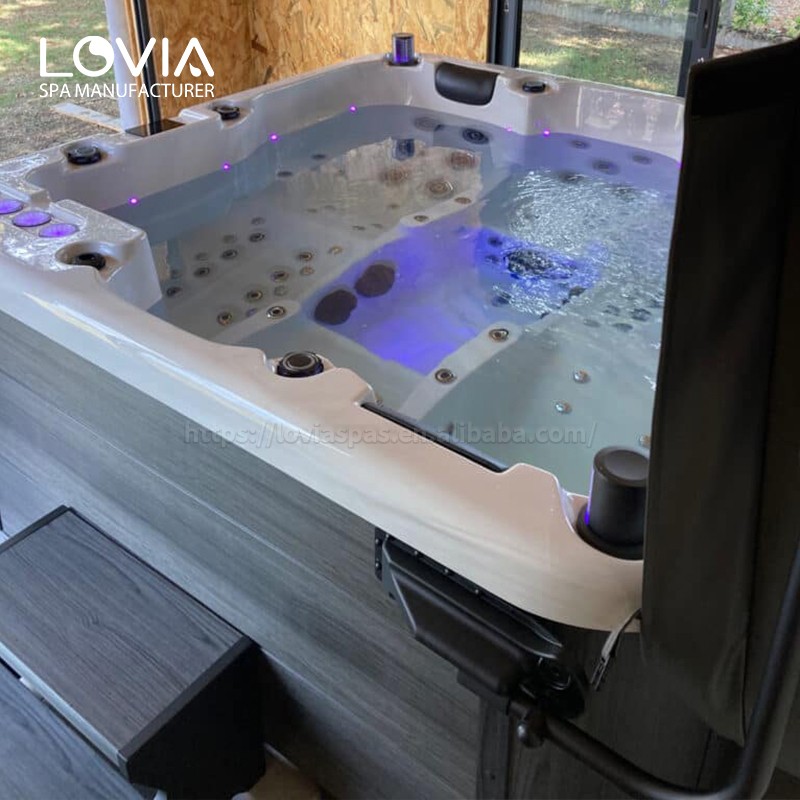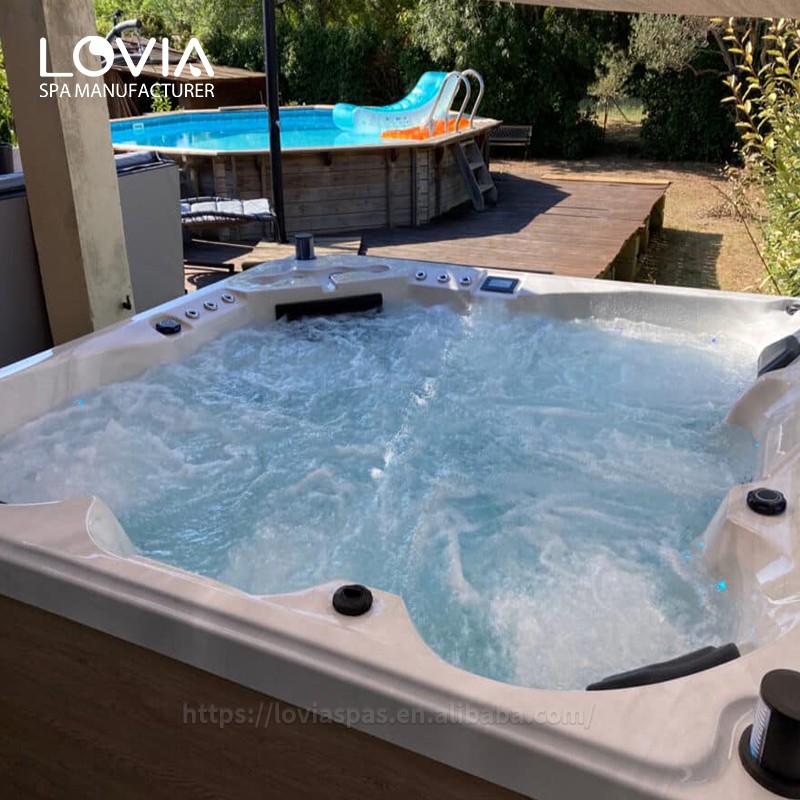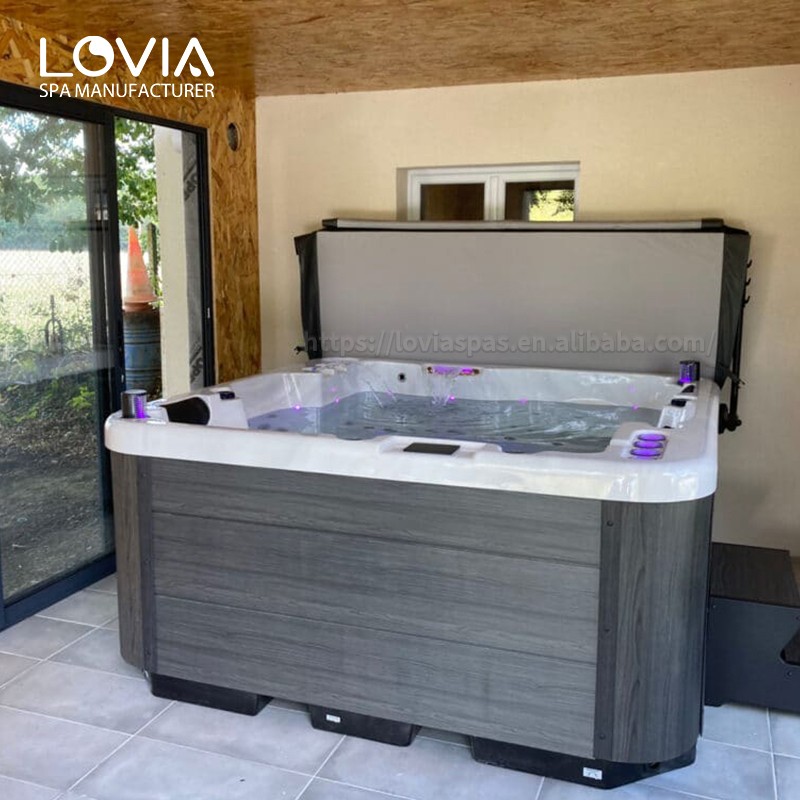
Which water treatment technology can I use in an outdoor spa jacuzzi tub?
2025-06-04 15:30While enjoying the comfort brought by hydrotherapy, the sanitation of water directly affects the health and experience of users. Therefore, water treatment technology becomes particularly important in outdoor spa jacuzzi tubs. Proper water treatment not only helps to extend the service life of the equipment, but also ensures that the water quality is sterile and odor-free, protecting the skin and health of users.
However, faced with a wide range of water treatment technologies on the market, many consumers may be confused and do not know which technology to choose to ensure the sanitation of spa jacuzzi tub water quality. Different water treatment methods have their own unique principles and advantages and disadvantages, and they are suitable for different types of spa jacuzzi tubs and user needs. Therefore, this article will explore the common water treatment technologies in outdoor spa jacuzzi tubs in depth to help consumers make scientific and reasonable choices.

Common water treatment technologies for outdoor spa jacuzzi tubs
In outdoor spa jacuzzi tubs, the main water treatment technologies include chemical disinfection, salt chlorination system, ozone water treatment, ultraviolet disinfection, and chlorine dioxide chlorination. Each technology has different advantages and applicable scenarios in terms of water quality cleaning. Consumers should choose the most suitable technology based on factors such as water quality requirements, personal health conditions, and frequency of use of spa jacuzzi tubs.
1. Chemical disinfection
Chemical disinfection is one of the traditional and widely used water treatment methods for outdoor spa jacuzzi tubs. Common chemicals include chlorine, bromine, hydrogen peroxide, etc. The basic principle is to kill bacteria, viruses and other harmful microorganisms in the water by adding specific chemicals to ensure clean water quality.
● Chlorination disinfection: Chlorine is one of the most common water disinfectants. Chlorine can effectively kill most bacteria and viruses after reacting with water, and is widely used in swimming pools and spa jacuzzi tubs. The advantages of chlorine are low cost and fast effect, but it may also cause odor in the water and may irritate sensitive parts such as skin and eyes.
● Bromination disinfection: Bromine is a substitute for chlorine and is often used in environments that are not suitable for the use of chlorine, such as hot springs, outdoor spa jacuzzi tubs, etc. Bromine has a strong antibacterial effect and is milder than chlorine, so it is less irritating to the skin and eyes. One disadvantage of bromine disinfection is that it is relatively expensive.
● Hydrogen peroxide disinfection: Hydrogen peroxide is an environmentally friendly water treatment chemical. When it decomposes in spa jacuzzi tub water, it releases oxygen, which can effectively oxidize organic matter and bacteria in the water. Compared with chlorine, hydrogen peroxide has fewer side effects, does not produce odor, and is less irritating to the skin and eyes. However, it works slowly and may increase the acidity of the water quality in long-term use.
Advantages and disadvantages analysis:
● Advantages: simple method, low cost, effective sterilization and disinfection, suitable for frequently used spa jacuzzi tubs.
● Disadvantages: May have side effects, such as irritation to the skin and eyes, and the concentration of chemicals in the water needs to be adjusted regularly.
2. Salt chlorination system (salt water hydrotherapy)
Salt chlorination system is a new water treatment technology that has gradually become popular in outdoor spa jacuzzi tubs in recent years. Its basic principle is to mix salt with water and convert salt into chlorine through an electrolysis process, thereby playing a disinfection and sterilization role. The main advantage of salt chlorination system is that it is relatively mild and less irritating to the skin and eyes.
● Advantages of salt chlorination: Salt chlorination system does not require the artificial addition of chemicals such as chlorine or bromine, but automatically generates chlorine gas through an electrolysis system, so it is more environmentally friendly. Salt water baths are excellent in water cleaning and odor removal, and are relatively gentle and will not cause dryness to the skin.
● Disadvantages of salt chlorination: Salt chlorination system is relatively expensive, electrolyzers need to be replaced regularly, and salt water may have a certain corrosive effect on outdoor spa jacuzzi tubs, so regular maintenance and inspection are required.
Advantages and disadvantages analysis:
● Advantages: easy operation, environmental protection, mild, no irritation to the skin, can maintain good water quality.
● Disadvantages: The initial equipment investment is high, and regular maintenance and replacement of related accessories are required.

3. Ozone water treatment
Ozone (O₃) is a strong oxidant commonly used in outdoor spa jacuzzi tub water treatment. Ozone water treatment system uses ozone gas to kill bacteria and viruses in water through water flow. The advantage of ozone as a disinfectant is that it can effectively remove organic pollutants, bacteria and viruses from water without any harmful residues.
● Advantages of ozone: Ozone water treatment is very efficient and has no side effects. It can not only disinfect outdoor spa jacuzzi tubs, but also decompose organic matter in water and remove odors, so it is considered a very environmentally friendly and safe way to treat water. Ozone disinfection does not leave the odor of chlorine and is less irritating to the skin and eyes.
● Disadvantages of ozone: The production of ozone requires specific equipment, and ozone is highly corrosive, so it may cause damage to spa jacuzzi tubs of certain materials. In addition, the effect of ozone is short-lived and requires real-time monitoring and continuous use.
Advantages and disadvantages analysis:
● Advantages: strong sterilization and disinfection effect, deodorization, environmental protection and safety, no irritation to the skin.
● Disadvantages: The equipment is expensive and requires regular inspection and maintenance, and special attention should be paid to safety when using it.

4. Ultraviolet disinfection
Ultraviolet (UV) disinfection is a non-chemical water treatment method that uses ultraviolet lamps to irradiate bacteria and viruses in the water, destroying their DNA or RNA, thereby achieving a disinfection effect. Ultraviolet disinfection is widely used in swimming pools, drinking water treatment and other fields, and has gradually entered the field of spa jacuzzi tubs.
● Advantages of ultraviolet light: UV disinfection has no chemical residues, does not irritate the skin and eyes, and has a very rapid sterilization effect. It can eliminate most harmful microorganisms in outdoor spa jacuzzi tub water, but does not change the water quality or produce odor, so it is favored by many users.
● Disadvantages of ultraviolet light: UV disinfection depends on the operation of the equipment and cannot remove organic pollutants or other impurities in the water except bacteria. Ultraviolet disinfection needs to be combined with other water treatment methods, such as filtration or chemical disinfection, to ensure that the water quality of outdoor spa jacuzzi tubs reaches the best standards.
Advantages and disadvantages analysis:
● Advantages: no chemical residues, rapid disinfection, skin-friendly.
● Disadvantages: cannot remove organic matter or impurities in spa jacuzzi tub water, and ultraviolet lamps need to be replaced regularly.
5. Chlorine dioxide water treatment
Chlorine dioxide (ClO₂) is a new type of water treatment chemical with a broad-spectrum bactericidal and disinfecting effect. It can effectively remove bacteria, viruses, algae and other harmful microorganisms in water. Chlorine dioxide is often used in outdoor spa jacuzzi tubs and has significant water purification, sterilization and disinfection effects.
● Advantages of chlorine dioxide: Chlorine dioxide has a strong oxidizing effect, which can quickly eliminate harmful microorganisms in water and remove odors and pollutants in water. Compared with traditional chlorides, chlorine dioxide is less irritating to the skin and eyes, and there is no residual chlorine smell after use.
● Disadvantages of chlorine dioxide: The concentration of chlorine dioxide needs to be strictly controlled during use. Excessive concentration may corrode the material of the spa jacuzzi tub. In addition, chlorine dioxide has a short duration of action in water and needs to be added continuously.
Advantages and disadvantages analysis:
● Advantages: strong bactericidal, odor removal, no chlorine residue.
● Disadvantages: The concentration needs to be strictly controlled and the cost is high.

How to choose the right water treatment technology for your spa jacuzzi tub?
Choosing the right water treatment technology requires considering multiple factors. Consumers should make choices based on their frequency of use, spa jacuzzi tub size, budget, environmental requirements, and water quality requirements.
1. Budget and maintenance costs
Different water treatment systems have large differences in initial investment and maintenance costs. For example, salt chlorination systems and ozone water treatment systems have higher initial investments, but lower long-term operating costs. Traditional chemical disinfection methods, such as chlorine and bromine, are relatively low in cost, but require frequent purchases of chemicals and have higher maintenance costs for long-term use.
2. Water quality requirements
If you have high requirements for outdoor spa jacuzzi tub water quality, want to keep the water clear, odor-free, and less irritating to the skin, ultraviolet disinfection and ozone water treatment may be more suitable. They can not only effectively kill bacteria, but also remove odors from the water, keeping the water clear and fresh.
3. Environmental awareness
If you are particularly concerned about environmental protection, you can choose salt chlorination systems or ozone water treatment technology. These technologies use fewer chemicals than traditional chemical disinfection methods, are environmentally friendly, and produce no harmful byproducts.
Your spa sourcing solution starts with Lovia Spa. We provide a complete selection of hot tubs and swim spas with competitive pricing and global shipment capabilities. As a certified Chinese spa manufacturer, we ensure compliance and performance in every unit. Whether you need branded units or white-label spas, our factory pricing and purchasing options make it simple to scale your spa business. Ask us about volume discounts and current sales campaigns.
